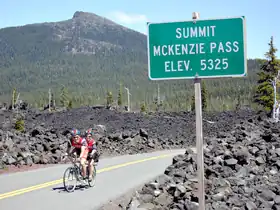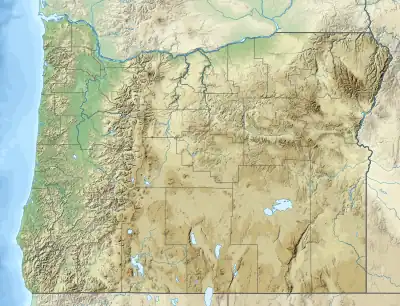McKenzie Pass
McKenzie Pass, elevation 5,325 feet (1,623 m),[1] is a mountain pass in the Cascade Range in central Oregon in the United States.[2]
| McKenzie Pass | |
|---|---|
 | |
| Elevation | 5,325 ft (1,623 m)[1] |
| Traversed by | |
| Location | Deschutes and Linn counties, Oregon, United States[2] |
| Range | Cascades |
| Coordinates | 44°15′35″N 121°48′35″W[2] |
 Location in Oregon | |
It is located at the border of Linn and Deschutes counties,[2] approximately 25 miles (40 km) northwest of Bend,[3] between the Three Sisters to the south and Mount Washington to the north. Oregon Route 242 goes over the pass.[1]
At the summit of the pass, Oregon Route 242 crosses a 65-square-mile (170 km2) lava flow just west of Sisters. Surrounded by lava, the Dee Wright Observatory was constructed in 1935 by Civilian Conservation Corps workers and named after their foreman. Visitors climb to the observatory to view the Cascade peaks visible from McKenzie Pass. Also near the summit is Clear Lake, a renowned location for fresh-water diving.
Highway 242 is not recommended for large trucks, trailers or motor homes due to numerous tight switchbacks. The pass is closed from November to July due to snow.
The pass is named for Donald McKenzie, a Scottish Canadian fur trader who explored parts of the Pacific Northwest for the Pacific Fur Company in the early 19th century.[4][5][6]
Climate
| Climate data for McKenzie Pass, Oregon(1981–2010) | |||||||||||||
|---|---|---|---|---|---|---|---|---|---|---|---|---|---|
| Month | Jan | Feb | Mar | Apr | May | Jun | Jul | Aug | Sep | Oct | Nov | Dec | Year |
| Average high °F (°C) | 32.9 (0.5) |
35.8 (2.1) |
39.0 (3.9) |
43.1 (6.2) |
51.9 (11.1) |
62.0 (16.7) |
72.1 (22.3) |
71.2 (21.8) |
61.0 (16.1) |
51.0 (10.6) |
37.5 (3.1) |
32.6 (0.3) |
51.0 (10.6) |
| Average low °F (°C) | 18.9 (−7.3) |
22.0 (−5.6) |
23.0 (−5.0) |
24.9 (−3.9) |
29.9 (−1.2) |
36.1 (2.3) |
42.1 (5.6) |
42.3 (5.7) |
37.1 (2.8) |
29.9 (−1.2) |
25.3 (−3.7) |
20.8 (−6.2) |
29.4 (−1.4) |
| Average precipitation inches (mm) | 12.2 (310) |
10.8 (270) |
9.0 (230) |
5.8 (150) |
3.6 (91) |
3.6 (91) |
1.1 (28) |
1.8 (46) |
3.8 (97) |
5.8 (150) |
11.7 (300) |
15.2 (390) |
84.4 (2,140) |
| Average snowfall inches (cm) | 69.7 (177) |
75.9 (193) |
75.4 (192) |
47.5 (121) |
13.5 (34) |
1.4 (3.6) |
0.1 (0.25) |
0.0 (0.0) |
1.4 (3.6) |
16.5 (42) |
59.4 (151) |
83.7 (213) |
444.4 (1,129) |
Astronaut training
Parts of central Oregon were used as a training grounds for Apollo astronauts between 1964 and 1966. The astronauts would practice walking on terrain that was similar to the surface of the Moon. In August 1964, Walter Cunningham struggled in a lava flow at McKenzie Pass, where he eventually fell and tore his space suit.[7] Cunningham piloted the lunar module on Apollo 7 in 1968.
References
- "McKenzie Highway". Oregon Department of Transportation. Retrieved January 8, 2018.
- "McKenzie Pass". Geographic Names Information System. United States Geological Survey, United States Department of the Interior. November 28, 1980. Retrieved January 31, 2018.
- "ArcGIS Web Application" (Map). The National Map. U.S. Geological Survey. Retrieved January 8, 2018.
- "Indians, Surveyors, Incidents Gave Names to Streams, Lakes and Mountains". Eugene Register-Guard. January 4, 1942. p. 5. Retrieved April 26, 2015.
- McArthur, Lewis A.; McArthur, Lewis L. (2003) [1928]. Oregon Geographic Names (7th ed.). Portland, Oregon: Oregon Historical Society Press. ISBN 978-0875952772.
- Mackenzie, Cecil Walter (1937). Donald Mackenzie, "King of the Northwest". Los Angeles, California: I. Deach, Jr. p. 91. OCLC 3023859.
- "Before the moon, NASA came here—Locations from Lava Butte to McKenzie Pass served as training ground for astronauts starting in the mid-1960s". The Bulletin. August 25, 1964.